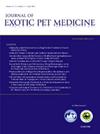Glossitis in four-toed hedgehogs (Atelerix albiventris): 7 cases (2003–2023)
IF 0.6
4区 农林科学
Q4 VETERINARY SCIENCES
引用次数: 0
Abstract
Background
Oral masses are a common finding in four-toed hedgehogs (Atelerix albiventris) under human care and are often diagnosed as neoplastic. Benign oral disease has also been reported, including inflammatory lesions of the oral mucosa and gingival hyperplasia. This retrospective study aimed to investigate cases of glossitis in hedgehogs, including signalment, clinical presentation, treatment protocol, and response to treatment.
Methods
Data was collected from three institutions over a 20-year period (October 2003–2023).
Results
A total of 1540 hedgehogs were evaluated during this time frame from all institutions and seven were identified with glossitis (overall prevalence 0.005%). Ages ranged from six months to five years (median 2.27 years), with five male intact, one male castrated, and one female intact animal. Most cases were treated on an emergency basis (6/7, 85.7%), with the most common presenting complaint being oral hemorrhage (5/7, 71.4%). Six cases (85.7%) were either grossly or histopathologically necrotic. Of the five with biopsies performed, all had acute suppurative glossitis, and two had a combination of acute and chronic disease. Treatment protocols with antibiotics and meloxicam were used in 6/7 cases (85.7%), and 4/7 (57.1%) achieved recorded or presumed resolution of clinical signs in two to twelve weeks.
Conclusions
While oral hemorrhage and swelling of the tongue are commonly associated with oral neoplasia in hedgehogs, glossitis with a more favorable outcome should also be included as a differential diagnosis and ruled out with ancillary testing.
四趾刺猬舌炎7例(2003-2023)
背景:在人类照料的四趾刺猬(Atelerix albiventris)中,口部肿块是一种常见的发现,通常被诊断为肿瘤。良性口腔疾病也有报道,包括口腔黏膜炎性病变和牙龈增生。本回顾性研究旨在调查刺猬舌炎的病例,包括信号,临床表现,治疗方案和治疗反应。方法从三个机构收集数据,时间跨度为20年(2003年10月- 2023年10月)。结果在这段时间内,所有机构共评估了1540只刺猬,其中7只被鉴定为舌炎(总患病率为0.005%)。年龄范围从6个月到5岁(中位2.27岁),5只雄性完整,1只雄性阉割,1只雌性完整。大多数病例是急诊(6/7,85.7%),最常见的主诉是口腔出血(5/7,71.4%)。6例(85.7%)为严重或组织病理学坏死。在进行活组织检查的5例患者中,所有患者都患有急性化脓性舌炎,其中2例患有急慢性疾病。6/7例(85.7%)使用抗生素和美洛昔康治疗方案,4/7例(57.1%)在2至12周内达到记录或推定的临床症状缓解。结论:虽然口腔出血和舌头肿胀通常与刺猬的口腔肿瘤有关,但结果更有利的舌炎也应作为鉴别诊断,并通过辅助检查排除。
本文章由计算机程序翻译,如有差异,请以英文原文为准。
求助全文
约1分钟内获得全文
求助全文
来源期刊

Journal of Exotic Pet Medicine
农林科学-兽医学
CiteScore
1.20
自引率
0.00%
发文量
65
审稿时长
60 days
期刊介绍:
The Journal of Exotic Pet Medicine provides clinicians with a convenient, comprehensive, "must have" resource to enhance and elevate their expertise with exotic pet medicine. Each issue contains wide ranging peer-reviewed articles that cover many of the current and novel topics important to clinicians caring for exotic pets. Diagnostic challenges, consensus articles and selected review articles are also included to help keep veterinarians up to date on issues affecting their practice. In addition, the Journal of Exotic Pet Medicine serves as the official publication of both the Association of Exotic Mammal Veterinarians (AEMV) and the European Association of Avian Veterinarians (EAAV). The Journal of Exotic Pet Medicine is the most complete resource for practitioners who treat exotic pets.
 求助内容:
求助内容: 应助结果提醒方式:
应助结果提醒方式:


